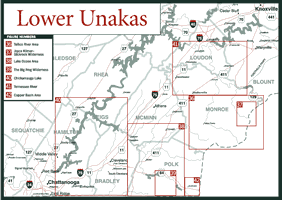
Since 1891, the federal government has set aside land for forest reserves, but in 1911, Congress passed the Weeks Law that allowed the purchase of land for national forests. The Weeks Law was perhaps more important to the eastern United States than to the West because growing populations in the East had already claimed most of the land. The goals of national forest laws—to protect watersheds and provide timber for the increasing population—were established by the Forest Management Act of 1897.
The Cherokee National Forest (CNF), like most southern national forests, once belonged to large timber companies. Much of the land was scarred from cutting and repeated wildfires. During the early days of the national forests in Tennessee, lands were purchased for two national forests. The lands in the northeastern part of the state became the Unaka National Forest that included land in North Carolina and Virginia. The lands in southeastern Tennessee became the Cherokee National Forest, to be covered here, and included land in Alabama, Georgia, and North Carolina.
President Woodrow Wilson, on June 14, 1920, officially proclaimed the two national forests be combined into one and called the Cherokee National Forest. In 1936, the national forests were reorganized by state lines. That gave Tennessee its present day form of the CNF. Separated from the Great Smoky Mountains National Park (GSMNP), the 633,000 acres of the CNF were separated into the northern and southern divisions. The southern division contains three ranger districts—(from north to south) Tellico, Hiwassee, and Ocoee—all named for the rivers flowing through them. These districts total 304,000 acres of timberland and watersheds.
Much of the early work of the United States Department of Agriculture's Forest Service concentrated on fire-fighting and acquisition of land. In the 1930s, the Civilian Conservation Corps built many recreation areas in the CNF.
The CNF takes its name from the Cherokee Indians who lived here before European settlers claimed the land for their own. Since 1960 when Congress passed the Multiple Use-Sustained Yield Act, the Forest Service has officially managed national forests for multiple purposes, including water, timber, wildlife, soil, minerals, cultural resources, wilderness, and outdoor recreation.
The Lower Unakas are sometimes referred to as the Unicoi Mountains. The geology of the Lower Unaka Mountains is similar to the Upper Unakas, and the flora and fauna are essentially the same in the southern division as in the northern one.